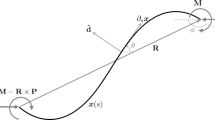Abstract
Inspired by the seminal works of Eshelby (Philos Trans R Soc A 244A:87–112, 1951, J Elast 5:321–335, 1975) on configurational forces and of Noll (Arch Ration Mech Anal 27:1–32, 1967) on material uniformity, we study a thermoelastic continuum undergoing volumetric growth and in a dynamical setting, in which we call the divergence of the Eshelby stress the Eshelby force. In the classical statical case, the Eshelby force coincides with the negative of the configurational force. We obtain a differential identity for the modified Eshelby stress, involving the torsion of the connection induced by the material isomorphism of a uniform body, which includes, as a particular case, that found by Epstein and Maugin (Acta Mech 83:127–133, 1990). In this identity, the divergence of the modified Eshelby stress with respect to this connection of the material isomorphism takes the name of modified Eshelby force. Moreover, we show that Eshelby’s variational approach (1975) can be used to formulate not only the balance of material momentum, but also the balance of energy. In this case, we find that what we call Eshelby power is the temporal analogue of the Eshelby force, and we obtain a differential identity for the modified Eshelby power. This leads to concluding that the driving force for the process of growth–remodelling is the Mandel stress. Eventually, we find that the relation between the differential identities for the modified Eshelby force and modified Eshelby power represents the mechanical power expended in a uniform body to make the inhomogeneities evolve.
Similar content being viewed by others
Change history
28 October 2020
In the original paper, we erroneously used the total potential energy (Helmholtz free energy of the material plus potential energy of the external forces) in the entropy inequality.
References
Bishop, R.L., Goldberg, S.I.: Tensor Analysis on Manifolds. Prentice-Hall, Upper Saddle River (1968)
Epstein, M.: Mathematical characterization and identification of remodeling, growth, aging and morphogenesis. J. Mech. Phys. Solids 84, 72–84 (2015)
Epstein, M., Elżanowski, M.: Material Inhomogeneities and Their Evolution. Springer, Berlin (2007)
Epstein, M., de León, M.: Unified geometric formulation of material uniformity and evolution. Math. Mech. Complex Syst. 4(1), 17–29 (2016)
Epstein, M., Maugin, G.A.: The energy momentum tensor and material uniformity in finite elasticity. Acta Mech. 83, 127–133 (1990)
Epstein, M., Maugin, G.A.: Thermomechanics of volumetric growth in uniform bodies. Int. J. Plast. 16, 951–978 (2000)
Ericksen, J.L.: Remarks concerning forces on line defects. In: Casey, J., Crochet M.J. (eds.) Theoretical, Experimental, and Numerical Contributions to the Mechanics of Fluids and Solids, pp. 247–271. Springer, Berlin (1995)
Ericksen, J.L.: On nonlinear elasticity theory for crystal defects. Int. J. Plast. 14, 9–24 (1998)
Eshelby, J.D.: The force on an elastic singularity. Philos. Trans. R. Soc. A 244A, 87–112 (1951)
Eshelby, J.D.: Energy relations and the energy-momentum tensor in continuum mechanics. In: Kanninen, M.F., et al. (eds.) Inelastic Behaviour of Solids, pp. 77–115. McGraw-Hill, New York (1970)
Eshelby, J.D.: The elastic energy-momentum tensor. J. Elast. 5, 321–335 (1975)
Federico, S.: Some remarks on metric and deformation. Math. Mech. Solids 20, 522–539 (2015)
Federico, S., Grillo, A., Segev, R.: Material description of fluxes in terms of differential forms. Contin. Mech. Thermodyn. 28, 379–390 (2016)
Green, A.E., Rivlin, R.S.: On Cauchy’s equations of motion. Z. Angew. Math. Phys. 15(3), 290–292 (1964)
Grillo, A., Federico, S., Giaquinta, G., Herzog, W., La Rosa, G.: Restoration of the symmetries broken by reversible growth in hyperelastic bodies. Theor. Appl. Mech. TEOPM7 30, 311–331 (2003)
Kobayashi, S., Nomizu, K.: Foundations of Differential Geometry. Wiley, New York (1963)
Marsden, J.E., Hughes, T.J.R.: Mathematical Foundations of Elasticity. Prentice-Hall, Englewood Cliff (1983)
Maugin, G.A.: On canonical equations of continuum thermomechanics. Mech. Res. Commun. 33, 705–710 (2006)
Noll, W.: La mécanique classique basée sur un axiome d’objectivité. In: The Foundations of Mechanics and Thermodynamics: selected papers by W. Noll, pp. Springer, Berlin (1974)
Noll, W.: Materially uniform bodies with inhomogeneities. Arch. Ration. Mech. Anal. 27, 1–32 (1967)
Wang, C.C., Bloom, F.: Material uniformity and inhomogeneity in anelastic bodies. Arch. Ration. Mech. Anal. 53(3), 246–276 (1974)
Acknowledgements
Libyan Ministry of Higher Education (MFA), Natural Sciences and Engineering Research Council of Canada through the NSERC Discovery Programme (ME, SF).
Author information
Authors and Affiliations
Corresponding author
Additional information
This work is dedicated to the memory of Prof. Gaetano Giaquinta (Catania, Italy, 25 November 1945–13 August 2016). Prof. Giaquinta was a professor of Structure of Matter at the Università di Catania (Italy) and a multiform intellectual. He has had a profound influence on his students, both from the scientific and the humanistic points of view, and has left an unbridgeable hole in their hearts.
Publisher's Note
Springer Nature remains neutral with regard to jurisdictional claims in published maps and institutional affiliations.
Rights and permissions
About this article
Cite this article
Alhasadi, M.F., Epstein, M. & Federico, S. Eshelby force and power for uniform bodies. Acta Mech 230, 1663–1684 (2019). https://doi.org/10.1007/s00707-018-2353-6
Received:
Revised:
Published:
Issue Date:
DOI: https://doi.org/10.1007/s00707-018-2353-6



